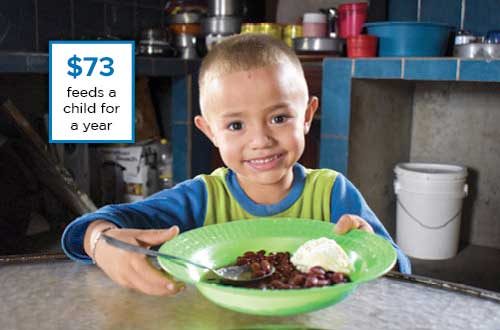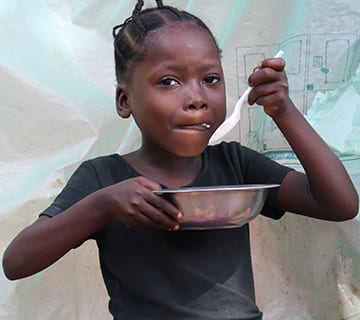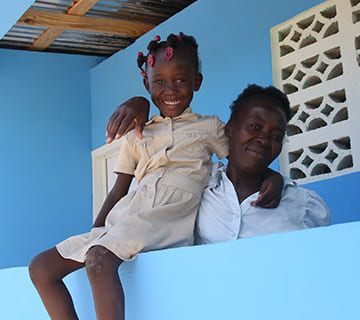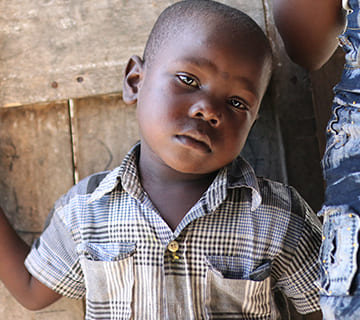
How We Help
Food For The Poor works every day to feed the hungry.
- In 2023, 229.8 million lifesaving meals were provided
- We operate and support programs that feed hundreds of thousands of people every day
- To accomplish this, we partner with churches, schools, hospitals, missionaries and charitable organizations
What Is Malnutrition?
Malnutrition is a condition that happens when a body is deprived of the nutrients it needs to be healthy.
A malnourished person with risk factors of malnutrition can be caused by insufficient protein, micronutrients, and minerals as well as mycotoxin contamination, diarrheal diseases, or parasites (or interaction between any of these factors). Mycotoxins are naturally occurring toxins produced by certain molds that can grow on crops and foods.
Can You Be Malnourished and Overweight?
Both an overweight person and an underweight person can suffer from malnutrition. The most common cause of malnutrition is a poor diet, but digestive issues or an underlying disease can contribute to malnutrition.
In developing countries across the Caribbean and Latin America, where extreme poverty crushes the lives of parents and their children, the challenge is more about getting sufficient protein and micronutrients (like iron and vitamins) since calorie intake is on average above the necessary requirement. The Caribbean does have issues with sufficient food and micronutrients, which are vital to healthy development and disease prevention.
The burden of food insecurity is heartbreaking to witness
Like seeing a mother in Haiti spread out a tattered woven mat in front of her tiny shack and sprinkle it with a handful of fish the size of paper clips, knowing that she’s not going to eat those fish. Instead, she’s hoping to sell them to buy one piece of fruit to feed her children.
Heartbreaking.
Or a mother in Latin America, who straps her baby to her back and brings her young sons into the coffee field, where they all pick fruit. Together, they might get paid enough to buy flour and oil to make tortillas.
Hidden Malnutrition: Starvation in rural communities
Struggling to survive on a meager $10 a week, 3-year-old Daysi and her eight family members lived deep in a forest in Latin America. Their home was perched on a mountainside, beneath a canopy of trees, surrounded by a coffee plantation. It sounds idyllic, but it was far from it. This family lived desperately below the poverty line, and their “home” was one room with a tiny work area attached. Lack of food affected the then-3-year-old Daysi the most. Daysi was too sick and lethargic from a lack of food to do anything but sit on the ground hunched over.
Most days, Daysi sat next to the kitchen fire, barely able to walk because of her severe malnutrition. The inky darkness inside Daysi’s shack made it nearly impossible to see anything clearly.

Daysi was physically wasting away from having very little food to eat. Her family lived so remotely that they could not afford transportation off the mountain to get to a doctor.
Her family’s lack of food had affected Daysi the worst. Daysi suffered in silence as she grew weaker and weaker. Daysi never had access to clean water; she slept on the dirt floor and was starving. There was no reason to believe this vulnerable and voiceless little one had any future ahead of her.
God had a plan

The local ministry of health started regular visits to Daysi and her family and compassionate donors and friends of FFTP gave gifts to build a home for the family. Daysi was on her way to recovery when sadly her caregiving grandparents died. With no other family available to take her in, the FFTP home was legally transferred into Daysi’s name for her future, and in the meantime, she was welcomed into an Angels Of Hope-supported children’s home where she is living, learning, and thriving.
What is the primary cause of global undernutrition?
Poverty is the leading cause of malnutrition globally. Many families struggling to survive will eat only carbohydrates in impoverished areas of the Caribbean and Latin America because fresh vegetables, fruit, and animal proteins like dairy, meat, and seafood are too expensive. Animal protein is the most important food type to consume to reduce malnutrition in children. As a result, children who eat diets filled with tortillas and beans might be overweight and shows signs of malnutrition.
UNICEF RESPONSE TO THE JOINT PUBLICATION, REGIONAL OVERVIEW OF FOOD SECURITY AND NUTRITION 2021:
“In Latin America and the Caribbean, COVID-19 has made a pre-existing malnutrition crisis worse. With services disrupted and livelihoods devastated, families are finding it harder to put healthy food on the table, leaving many children hungry and others overweight. For children to grow up healthy, we need to ensure all families access affordable, nutritious food,” said Jean Gough, UNICEF Regional Director for Latin America and the Caribbean.
In Haiti, where about 4.4 million people out of a population of 11 million are estimated to be food insecure (Integrated Food Security Phase Classification, 2021), the prevalence of undernourished children is high.
It is not uncommon to find mothers living in extreme poverty who have taught their children how to tie a piece of material tightly around their waists to numb the hollow ache of their hunger.
Malnourishment vs. Undernourishment
What is the difference between malnutrition and undernourishment? Malnutrition and undernourishment are two terms that get used interchangeably, but they are different. Undernourishment means that a person is eating but not getting valuable nutrients. Malnutrition means a person isn’t getting enough food or is getting too much food.
Four types of undernourishment
Undernourished children are incredibly vulnerable to disease and death.
What is undernourishment? Undernourishment includes wasting, stunting, being underweight, and having micronutrient deficiencies.
Malnutrition seems to be most damaging if it occurs during childhood.
Below are four types of undernourishment in context to children:
1. Wasting is when a child has a low weight-for-height. When you see a child with low weight-for-height, this typically means their severe weight loss stems from having not eaten for some time or suffering a complication such as diarrhea. The risk of death increases significantly when a child experiences severe or even moderate wasting. Wasting can be temporary and remedied rather quickly while stunting can cause permanent changes.
2. Stunting is when a child has a low height for their age. You see this in children living with generational poverty. Parents living in extreme poverty often have poor health, malnutrition and frequent illnesses, making it more likely that their children will suffer the same. Stunting holds a child back from reaching their physical and learning potential.
3. Underweight is when a child has a low weight for their age. An underweight child may show signs of being stunted, wasted or both.
4. Micronutrient deficiencies happen when a child’s diet lacks crucial vitamins and minerals such as folate, iodine, iron, vitamin A and zinc.
The effects of malnutrition in children can be fatal.
A child with deficiencies in one or more vital vitamins and minerals is at risk of impeded growth, metabolism and development. A child’s nutritional status affects their development but having a significant shortage of micronutrients can lead to grave illnesses and physical impairments, including anemia, blindness and intellectual disability.
Parents in developing countries notice the symptoms of malnutrition in their children that include fatigue, dizziness and pronounced weight loss.
Equally disturbing are two forms of severe malnutrition: kwashiorkor and marasmus.
What is the difference between kwashiorkor and marasmus?
Kwashiorkor happens when a person doesn’t consume enough protein and marasmus happens when a person isn’t consuming any carbohydrates, fats and proteins.
In children, marasmus presents as an underweight body with little muscle or fat and kwashiorkor presents with swollen arms and legs and a bloated stomach from fluid retention.
Why is malnutrition a problem?
Malnutrition keeps children, parents and entire communities from reaching their full potential. Malnourished children are more likely to fall behind in school, limiting their future earning potential.
Malnourished adults are less able to work, which means they cannot contribute to the well-being of their communities or provide for their families.
Malnourished mothers will likely have underweight children. Breastfeeding is one of the best ways for a mother to give nutrients to her growing baby.
But when a mother is highly malnourished, she cannot breastfeed. And a malnourished child will have a greater risk of intellectual and physical impairment.
Malnutrition and its effects fuel the devastating cycle of poverty and stifle growth in already struggling economies.
It’s impossible to escape the knowledge that children born into extreme poverty face a life of hunger and suffering.
But this is a preventable outcome. We have the power, the solutions and the means to prevent malnutrition. So how do we get started?
You Are Part of the Solution
Having enough nutritious food to eat is a necessity for human growth and development.
You can partner with Food For The Poor in supporting the U.N. Sustainable Development Goals (SDG) to provide food and ensure healthier lives.
SDG 2 (zero hunger) and SDG 3 (good health and well-being) encompass ending hunger, achieving food security, improved nutrition, sustainable agriculture, ensuring healthy lives and promoting well-being for everyone of all ages. Malnutrition isn’t only present in emergencies, wars or natural disasters. Malnutrition can manifest over decades.
Communities living in extreme poverty can pass the effects of malnutrition from generation to generation.
Malnutrition statistics show that an estimated 1 million children living in extreme poverty die from severe acute malnutrition every year. Acute malnutrition happens when your body isn’t receiving enough nutrients to support normal body functions.
In severe acute malnutrition, a body’s organs will slow down, sapping energy, and making a person feel lethargic. This internal shutdown occurs because the body’s energy reserves are entirely gone – tapped out.
Prevention and treatment of malnutrition are essential to helping families and communities live long, healthy lives. When a community has the tools and the education needed to understand how malnutrition occurs and what to do within their community to prevent it, they will break the cycle of poverty and food insecurity.
Because of the kindness of donors like you, FFTP provides lifesaving food and supports programs for malnourished children and needy families.
You are empowering communities with even more options to care for their children. FFTP utilizes strong and trusted partnerships in each community to monitor and integrate solutions for hunger and malnutrition.
Community partnerships and existing intervention programs in communities are strengthened and empowered by your support.
Your generosity also gives FFTP the capability to implement innovative lifesaving programs to prevent malnutrition.
Solutions to Prevent Malnutrition
Mothers who are desperate to help their children benefit from in-home care solutions and treatment for their malnourished children.
Having trusted partners within local communities also breaks down barriers to educating mothers on breastfeeding and gives valuable insight into the specific problems facing mothers in each community.
The therapeutic solutions mothers give their children include special nut butter pastes, which are packed with essential proteins and nutrients, and vitamin-dense meals ready to eat after adding hot water. Livestock or egg programs help provide vital animal protein. Also, treated water that is safe to drink is an essential part of reducing malnutrition. Untreated water can cause waterborne diseases and parasites, affecting the body’s ability to absorb nutrients.
We Serve a Mighty God
We know that God goes before us. Only because of God, FFTP continues to transform lives and communities.
You will experience a transformation, too. The true nature of the gospel of the Lord is life-changing and life-giving.
Your faithfulness and sacrificial generosity can provide vulnerable children with the chance to live the life God has promised them.
You are part of the solution to save children living with malnutrition.
Your Impact Saves Lives
You can impact hungry communities that need you.
Did you know that so far in 2022, FFTP has provided more than 94 million meals?
Your support means that FFTP can quickly and efficiently ship food to nutrition centers, clinics, churches, schools and feeding programs throughout extremely impoverished areas in the Caribbean and Latin America.
Malnutrition is a complex and often deadly circumstance for poverty-stricken children and communities.
But your sacrifice to help feed hungry children and families puts the power to deliver nutrition into local communities in the Caribbean and Latin America.
Community-based monitoring of children and families means that children’s growth rates are recorded and monitored. In addition, visits by healthcare workers ensure immediate interventions if necessary.
And by closely watching communities, FFTP is alerted to early warning signs of food insecurity, which helps save lives, avoid famine conditions, and reduce the possibility of needing to send an emergency crisis response.
Home visits by health workers increase community trust and allow FFTP to research and implement more ways to bring nutritious food and health education programs to vulnerable groups. Severe cases of malnutrition can also be identified and quickly referred to local hospitals, saving even more lives.
From Heartbreak to Health and Empowerment
Because of you, local churches, nutrition clinics, schools and feeding programs transform the lives of hungry and desperate families in communities that desperately need you.
With your support, the programs that FFTP runs in the Caribbean and Latin America to help prevent malnutrition continue to deliver sustainable solutions, including agriculture education, community health monitoring, and supplying clinics with needed medicines and ready-to-eat nutritional therapies and vitamin-packed meals.
FFTP’s outreach and connection with churches and clinics in local communities give the organization the opportunity to help directly and the ability to prevent malnutrition before it becomes a life-threatening issue.
Thank you for partnering with FFTP in the fight to prevent malnutrition.





